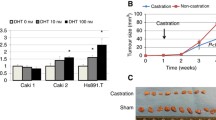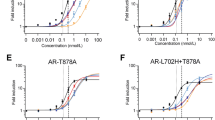Abstract
Purpose
Androgen receptors (ARs) are expressed on a variety of cell types, and AR signaling plays an important role in tumor development and progression in several cancers. This in vitro study evaluated the effect of dihydrotestosterone (DHT) on the proliferation of renal cell carcinoma (RCC) cells in relation to AR status.
Methods
Steroid hormone receptor expression was evaluated using RT-PCR and Western blotting. The effect of DHT on cell proliferation and STAT5 phosphorylation was evaluated in RCC cell lines (Caki-2, A498, and SN12C) and primary RCC cells using cell viability assays and Western blotting. ARs and glucocorticoid receptors (GRs) were knocked down with small interfering RNAs before assessing changes in cell proliferation and STAT5 activation.
Results
DHT treatment promoted cell proliferation and increased STAT5 phosphorylation regardless of AR status. The AR antagonist bicalutamide reduced kidney cancer cell proliferation, regardless of AR status. AR and GR knockdown blocked STAT5 activation and reduced cell proliferation in all RCC cell lines. In patient-derived primary cells, DHT enhanced cell proliferation and this effect was diminished by treatment with the AR antagonists bicalutamide and enzalutamide and the GR antagonist mifepristone.
Conclusion
DHT promotes cell proliferation through STAT5 activation in RCC cells, regardless of AR status. DHT appears to utilize the AR and GR pathways to activate STAT5, and the inhibition of AR and GR showed antitumor activity in RCC cells. These data suggest that targeting AR and GR may be a promising new approach to the treatment of RCC.




Similar content being viewed by others
References
Alexander SP et al (2015) The concise guide to PHARMACOLOGY 2015/16: nuclear hormone receptors. Br J Pharmacol 172:5956
Arora VK et al (2013) Glucocorticoid receptor confers resistance to antiandrogens by bypassing androgen receptor blockade. Cell 155:1309–1322. https://doi.org/10.1016/j.cell.2013.11.012
Atsaves V et al (2017) PD-L1 is commonly expressed and transcriptionally regulated by STAT3 and MYC in ALK-negative anaplastic large-cell lymphoma. Leukemia 31:1633
Austin JW, Lu P, Majumder P, Ahmed R, Boss JM (2014) STAT3, STAT4, NFATc1, and CTCF regulate PD-1 through multiple novel regulatory regions in murine T cells. J Immunol 192(10):4876–4886. https://doi.org/10.4049/jimmunol.1302750
Bianchi M, Meng C, Ivashkiv LB (2000) Inhibition of IL-2-induced Jak-STAT signaling by glucocorticoids. Proc Natl Acad Sci 97:9573–9578
Bray F, Ferlay J, Soerjomataram I, Siegel RL, Torre LA, Jemal A (2018) Global cancer statistics 2018: GLOBOCAN estimates of incidence and mortality worldwide for 36 cancers in 185 countries. CA Cancer J Clin 68:394–424
Bromberg J, Darnell JE (2000) The role of STATs in transcriptional control and their impact on cellular function. Oncogene 19:2468
Buettner R, Mora LB, Jove R (2002) Activated STAT signaling in human tumors provides novel molecular targets for therapeutic intervention. Clin Cancer Res 8:945–954
Chang C, Lee S, Yeh S, Chang T (2014) Androgen receptor (AR) differential roles in hormone-related tumors including prostate, bladder, kidney, lung, breast and liver. Oncogene 33:3225
Choueiri TK, Motzer RJ (2017) Systemic therapy for metastatic renal-cell carcinoma. N Engl J Med 376:354–366
Choueiri TK et al (2016) Cabozantinib versus everolimus in advanced renal cell carcinoma (METEOR): final results from a randomised, open-label, phase 3 trial. Lancet Oncol 17:917–927
Ferbeyre G, Moriggl R (2011) The role of Stat5 transcription factors as tumor suppressors or oncogenes. Biochimica Et Biophysica Acta (BBA) Rev Cancer 1815:104–114
Ha Y-S, Lee GT, Modi P, Kwon YS, Ahn H, Kim W-J, Kim IY (2015) Increased expression of androgen receptor mRNA in human renal cell carcinoma cells is associated with poor prognosis in patients with localized renal cell carcinoma. J Urol 194:1441–1448
He D et al (2014a) ASC-J9 suppresses renal cell carcinoma progression by targeting an androgen receptor-dependent HIF2α/VEGF signaling pathway. Can Res 74:4420–4430
He D et al (2014b) New therapy via targeting androgen receptor → HIF-2α → VEGF signals with ASC-J9® to suppress renal cell carcinoma progression. Cancer Res 2681:2013
Hoang DT et al (2015) Inhibition of Stat5a/b enhances proteasomal degradation of androgen receptor liganded by antiandrogens in prostate cancer. Mol Cancer Ther 14:713–726
Horiguchi A, Oya M, Shimada T, Uchida A, Marumo K, Murai M (2002) Activation of signal transducer and activator of transcription 3 in renal cell carcinoma: a study of incidence and its association with pathological features and clinical outcome. J Urol 168:762–765
Johnson DE, O’Keefe RA, Grandis JR (2018) Targeting the IL-6/JAK/STAT3 signalling axis in cancer. Nat Rev Clin Oncol 15:234
Jonasch E, Gao J, Rathmell WK (2014) Renal cell carcinoma. BMJ 349:g4797
Langner C, Ratschek M, Rehak P, Schips L, Zigeuner R (2004) Steroid hormone receptor expression in renal cell carcinoma: an immunohistochemical analysis of 182 tumors. J Urol 171:611–614
Lee GT et al (2017) Intracrine androgen biosynthesis in renal cell carcinoma. Br J Cancer 116:937
Li S et al (2013) Icaritin inhibits JAK/STAT3 signaling and growth of renal cell carcinoma. PLoS One 8:e81657
Lucca I, Klatte T, Fajkovic H, De Martino M, Shariat SF (2015) Gender differences in incidence and outcomes of urothelial and kidney cancer. Nat Rev Urol 12:585
Motzer RJ et al (2015) Nivolumab versus everolimus in advanced renal-cell carcinoma. N Engl J Med 373:1803–1813
Nikolić M et al (2015) Possible involvement of glucocorticoids in 5α-dihydrotestosterone-induced PCOS-like metabolic disturbances in the rat visceral adipose tissue. Mol Cell Endocrinol 399:22–31
Siegel RL, Miller KD, Jemal A (2017) Cancer statistics, 2017. CA Cancer J Clin 67:7–30
Song C, Jun S-Y, Hong J-H, Ahn H (2007) Transforming growth factor-β downregulates interleukin-2-induced phosphorylation of signal transducer and activator of transcription 5 in human renal cell carcinoma. J Cancer Res Clin Oncol 133:487–492
Song C, Kim Y, Min GE, Ahn H (2014) Dihydrotestosterone enhances castration-resistant prostate cancer cell proliferation through STAT5 activation via glucocorticoid receptor pathway. Prostate 74:1240–1248
Stöcklin E, Wissler M, Gouilleux F, Groner B (1996) Functional interactions between Stat5 and the glucocorticoid receptor. Nature 383:726
Stone L (2014) Androgen receptor—a new target in renal cell carcinoma? Nat Rev Urol 11:425–426
Tan S-H et al (2008) Transcription factor Stat5 synergizes with androgen receptor in prostate cancer cells. Can Res 68:236–248
Vogelstein B, Kinzler KW (2004) Cancer genes and the pathways they control. Nat Med 10:789
Wang K, Sun Y, Tao W, Fei X, Chang C (2017) Androgen receptor (AR) promotes clear cell renal cell carcinoma (ccRCC) migration and invasion via altering the circHIAT1/miR-195-5p/29a-3p/29c-3p/CDC42 signals. Cancer Lett 394:1–12
Whitfield GK, Jurutka PW, Haussler CA, Haussler MR (1999) Steroid hormone receptors: evolution, ligands, and molecular basis of biologic function. J Cell Biochem 75:110–122
Wingelhofer B et al (2018) Implications of STAT3 and STAT5 signaling on gene regulation and chromatin remodeling in hematopoietic cancer. Leukemia 32(8):1713–1726. https://doi.org/10.1038/s41375-018-0117-x
Xin H, Zhang C, Herrmann A, Du Y, Figlin R, Yu H (2009) Sunitinib inhibition of Stat3 induces renal cell carcinoma tumor cell apoptosis and reduces immunosuppressive cells. Cancer Res. https://doi.org/10.1158/0008-5472.Can-08-4323
Yakirevich E et al (2011) Expression of the glucocorticoid receptor in renal cell neoplasms: an immunohistochemical and quantitative reverse transcriptase polymerase chain reaction study. Hum Pathol 42:1684–1692
Yu H, Lee H, Herrmann A, Buettner R, Jove R (2014) Revisiting STAT3 signalling in cancer: new and unexpected biological functions. Nat Rev Cancer 14:736
Zhang N, Zeng Y, Du W, Zhu J, Shen D, Liu Z, Huang J-A (2016) The EGFR pathway is involved in the regulation of PD-L1 expression via the IL-6/JAK/STAT3 signaling pathway in EGFR-mutated non-small cell lung cancer. Int J Oncol 49:1360–1368
Zhao H, Leppert JT, Peehl DM (2016) A protective role for androgen receptor in clear cell renal cell carcinoma based on mining TCGA data. PLoS One 11:e0146505
Zhu G et al (2014) The expression and evaluation of androgen receptor in human renal cell carcinoma. Urology 83:510.e519–510.e524
Acknowledgements
This study was supported by a Grant (W2014-012) from the Asan Institute for Life Sciences, Asan Medical Center, Seoul, Korea.
Author information
Authors and Affiliations
Corresponding author
Ethics declarations
Conflict of interest
The authors declare no conflict of interest.
Additional information
Publisher's Note
Springer Nature remains neutral with regard to jurisdictional claims in published maps and institutional affiliations.
Electronic supplementary material
Below is the link to the electronic supplementary material.
Rights and permissions
About this article
Cite this article
Pak, S., Kim, W., Kim, Y. et al. Dihydrotestosterone promotes kidney cancer cell proliferation by activating the STAT5 pathway via androgen and glucocorticoid receptors. J Cancer Res Clin Oncol 145, 2293–2301 (2019). https://doi.org/10.1007/s00432-019-02993-1
Received:
Accepted:
Published:
Issue Date:
DOI: https://doi.org/10.1007/s00432-019-02993-1




